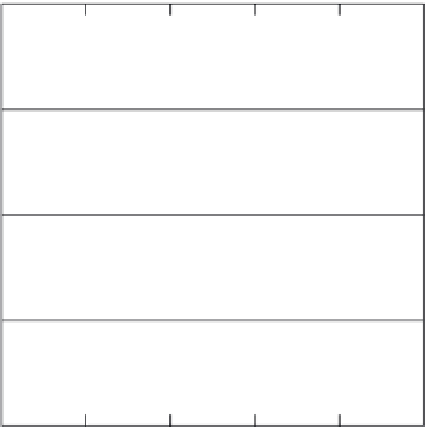Environmental Engineering Reference
In-Depth Information
excess of 100%, indicated that the model solu-
tion was nonunique. It was concluded that dif-
ferent combinations of parameter values could
produce similar simulation results.
A
Example: Mirror Lake, New Hampshire
A groundwater modeling study was con-
ducted for the Mirror Lake area in central New
Hampshire to develop an understanding of
the three-dimensional extent of the basin and
to quantify components of the groundwater
budget, including recharge (Tiedeman
et al
.,
1997
). The 10 km
2
study area is characterized
by steep hillsides and relatively flat valleys. The
groundwater system is contained in fractured
crystalline bedrock and the glacial deposits that
overlie the bedrock in most of the basin. Most
recharge occurs as direct infiltration from pre-
cipitation. Seepage from the lake and streams is
a secondary source of recharge.
The three-dimensional model domain was
represented by a grid of 89 rows, 85 columns,
and 5 layers. Grid spacing ranged from 17 to
150 m on a side. The bottom of the grid was at a
depth of 150 m. No-flow boundaries were applied
on all sides of the model domain. Streams were
simulated with the Streamflow Routing Package
of MODFLOW. It was assumed that steady-state
conditions existed and that recharge from pre-
cipitation was spatially uniform. Recharge and
hydraulic conductivity of three zones (glacial
deposits, lower bedrock, and upper bedrock)
were estimated by using the inverse modeling
capability in the MODFLOWP program (Hill,
1992
). Four separate calibrations with different
hypothetical zonations of hydraulic conductivity
were run. Calibration data included long-term
average water levels from 89 wells and piezome-
ters and average base flow in three streams that
flow into Mirror Lake. Base flow was assumed to
be 40% of the long-term average streamflow, on
the basis of work by Mau and Winter (
1997
).
Simulated groundwater levels and base flows
were similar to measured values in all calibra-
tions. The estimated recharge rates of 260 to
280 mm/yr (
Figure 3.12
) were equivalent to 19 to
20% of average precipitation. The approximate,
individual, 95% confidence intervals shown in
Figure 3.12
were calculated under assumptions
B
C
D
0
100
200
300
400
500
Recharge (mm/y)
Figure 3.12
Estimated recharge rates (dots) and
approximate, individual, 95% confidence intervals
(bars) derived from four calibrations of the Mirror Lake
groundwater-flow model (Tiedeman
et al
.,
1997
).
that the model behaved linearly with respect
to parameter values in the neighborhood of the
optimal values and that residuals (differences
between observed and simulated quantities)
were independent and normally distributed.
The validity of these assumptions was discussed
by Tiedeman
et al
. (
1997
). Base-flow data allowed
model parameters to be uniquely determined. If
water-level data alone were used for calibration,
only the best-fit ratios of recharge to hydraulic
conductivity could have been determined
because of high correlation between these vari-
ables. An important finding of the modeling
analysis was that the groundwater basin within
which Mirror Lake lies is much larger than the
surface-water basin. If the groundwater model
had been constructed with boundaries at the
surface-water basin boundaries, the estimated
recharge would have been about 50% higher.
Example: Middle Rio Grande Basin
Groundwater in the Middle Rio Grande Basin of
central New Mexico serves as the primary water
source for the city of Albuquerque and the sur-
rounding area. Sanford
et al
. (
2004
) describe a
groundwater-flow model within the basin that
was calibrated with groundwater levels and






